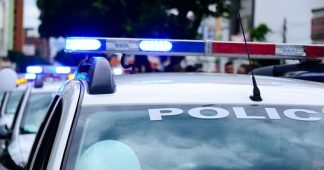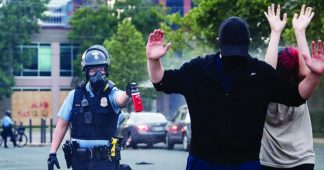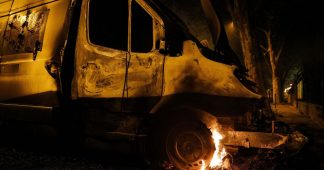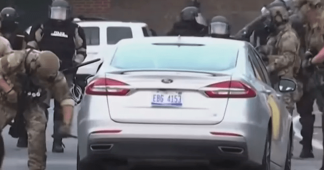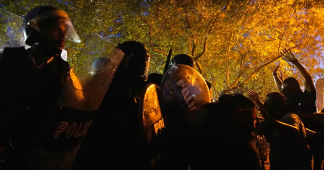By seizing the cops’ home base, rioters showed that law enforcement is not above the forces of history.
By Vicky Osterweil
Jun 12, 2020
Calls to abolish the police are spreading. Dozens of cities are considering cutting police budgets, and police are resigning across the country. In Minneapolis, where the police murdered George Floyd and the insurrection first broke out, the city council is moving to disband the police department. While this would only be a first step toward full abolition—which would require ending all forms of policing, evictions, imprisonment, courts, and racial capitalism—three weeks ago, that a major city would even consider this was unthinkable.
For many who’ve been fighting for police abolition for years, the sudden uptake of these ideas has been disorienting. Gratifying, certainly, but also surprising and overwhelming. Many respond with frustration, as the meaning of abolition is watered down, reduced to defunding or even less drastic reforms. Black people in America have lived through a partial abolition before: The enslaved overthrew the regime of slavery in what W.E.B. Du Bois called the General Strike of the Slaves, only for it to be reinstituted in all but name in convict leasing, sharecropping, Jim Crow, vigilante white terrorism, chain gangs, and prisons. Abolition not accompanied by a social revolution will just be another in the long history of white supremacist “reforms” that allow this settler state to continue as it always has.
But even with these caveats, the question remains: How did this demand jump from a small, mostly black contingent of revolutionary thinkers to the mainstream in the span of a few weeks? The most obvious answer is two weeks of rioting, looting, and protesting. That is correct, of course, but it’s not enough. Rioting and looting against the police took place in Ferguson, Mo., and eventually across the country, following the murders of Michael Brown and Eric Garner in 2014; Baltimore rose up against the killing of Freddie Gray in 2015; and Charlotte, N.C., saw looted and overturned semitrucks turned into burning highway barricades for Keith Lamont Scott in 2016. And yet the call that emerged out of that movement was for officers to wear body cameras.
The difference, this time, is not simply in the national character of the riots, nor some other quantitative change in their ferocity or visibility. It was, I believe, the destruction of the Minneapolis Third Precinct house on the night of May 28, three days into the riots. Having just completed a book on the history of anti-police rioting and uprisings in America, I cannot recall another time when protesters took over and burnt down a police station. It was an unprecedented and beautiful moment in the annals of rebellion in this country. By seizing the cops’ home base, rioters showed millions of people that they could defeat the police. For many, it finally broke through the veil of omnipotence, timelessness, and domination that kept abolition from seeming possible. Police were returned to the realm of history.
The police are rarely imagined to have a history at all. As Kristian Williams, a historian of the police, writes in Our Enemies in Blue, people “seem to imagine that the cop has always been there, in something like his present capacity, subject only to the periodic change of uniform or the occasional technological advance.” But what the rioters of Minneapolis demonstrated by torching the police base in their community is that cops are just people operating out of ordinary buildings. Particularly powerful and cruel people, yes, but they’re individuals no more free from the forces of history than the rest of us.
The dehistoricization of the police is a long and constant project of the US state and media apparatus. There are thousands, perhaps millions of hours of TV and movies full of mythologizing stories about the police. There are heroic police, conflicted police, troubled cops with a heart of gold, good cops taking on corrupt cops, slapstick cops, and genius cops. The detective is the only profession in America that has its own wildly popular genre of novels. And news media gives a constant and free platform to police (often in exchange for special access).
And yet, none of this vast media project concerns the early history of the police. Almost none of us learn in school about the emergence of the police in the 19th century and their role in the oppression and control of black communities. We don’t learn about how they took techniques and inspiration from colonial forces in Caribbean slave colonies. We definitely don’t hear that the first modern police force in the world, the Charleston South Carolina City Guard, was formed to terrorize and control the city’s slave quarters.
Antebellum Southern urban economies were built around the practice of enslavers “hiring out” laborers to other employers in town. These enslaved workers earned a wage from their bosses, most of which they would then turn over to their enslaver. These laborers most often lived together, usually at a remove from both their employer and their enslaver, and their lives outside work unfolded mostly in black neighborhoods known as slave quarters. These communities were spaces of relative autonomy for the enslaved, and as such were a cause of anxiety to white residents, who feared the possibility of black peoples’ organization and rebellion. These neighborhoods were frequently outside of white control. They were places where the enslaved and free alike could organize and trade; where recent fugitives could hide out and Underground Railroad stations could form; where African, Creole, and subversive Christian religious practices could flourish; and where white people weren’t respected, deferred to, or welcomed.
Such communities threatened the slave order. So Southern cities developed “city guards,” militarized forces of young white men whose large numbers and modern weaponry allowed them to patrol and control those quarters. The earliest of these, in Charleston, S.C., is history’s first modern police force, formed in 1783, though most other early police forces, like the NYPD, wouldn’t even emerge until the 1840s.
Nor do we learn that one of the main tasks of the earliest Northern police force, alongside repressing strikes and other labor unrest, was to enforce the Fugitive Slave Act. Cops kidnapped and returned black people who escaped captivity and put down anti-slave-catcher riots and protests. Another way standard history obscures the possibility of abolition is by erasing the role of the militant and often riotous urban vigilance committees of black freedmen in the Underground Railroad. We don’t learn that prisons—places where people are held for years as punishment in and of itself, as opposed to jails or dungeons where people were held preceding trial or execution—only emerged in the 1820s. And we don’t learn that because if we did, we might begin to imagine a world without them.
Wherever they appeared in the United States, police were the first urban bureaucracies. Law enforcement provided most urban governmental services in the 19th century. Only slowly, as their utility to city governments became clear and their burden grew larger and larger, did cities begin creating new departments to handle urban tasks like sanitation and transportation. In other words, the model of bureaucratic urbanism that dominates and organizes our cities is made in the image of these anti-black police departments, in the image of slave catchers, white terrorists, and colonial officers. It is this history that abolition seeks to break with, and why it would mean uprooting the entire anti-black system.
So how did one moment of direct action in Minneapolis serve to counter years of disinformation, miseducation, and media violence? Black Panther Party cofounder Huey P. Newton, in a speech called “The Correct Handling of a Revolution,” analyzed how rioting like what took place in Watts in 1965 was politically powerful because it could not be reinterpreted by the press. In Watts, Newton said, “the economy and property of the oppressor was destroyed to such an extent that no matter how the oppressor tried in his press to whitewash the activities of the Black brothers, the real nature and cause of the activity was communicated to every Black community.” This kind of communication is what we saw in Minneapolis at the end of May. Martin Luther King Jr. famously said that “riots are the language of the unheard,” but rioters do not address themselves to the state, the bosses, or the politicians. Instead they speak to each other, over the heads of the media and the white establishment, with words of fire and punctuation of broken glass.
As I write this, the riots have receded, but the movement is not slowing down. The media, having demonized the rioters, has tried to go back to ignoring peaceful protest. But the capture of another police precinct, this one the East Precinct in Seattle, has led to the creation of the Capitol Hill Autonomous Zone (CHAZ), six blocks of rioter territory defended by barricades. The CHAZ is such an impressive provocation that it caused Donald Trump to have one of his Twitter meltdowns, but it has also been intensely weakened by nonviolence advocates, local politicians, and “peace police,” who refused to let the building be attacked. Instead, it sat empty and unharmed inside the CHAZ, allowing for the police to reenter it on June 11.
It is truly incredible that two precinct houses have fallen in the space of two weeks, and that fact has already dramatically shifted the calculus of what is possible. But while the burning of the Third Precinct building in Minneapolis led to countrywide riots and the emergence of police abolition as a mainstream argument, the hesitation in the CHAZ may mean the movement in Seattle has much less significant long-term impact in the abolitionist imagination. Nevertheless, events continue to unfold, and the example of creating a cop-free resistance zone is leading organizers and rioters around the country to think more boldly and openly about new tactics. It is a real-time lesson in the wisdom of action, the power of crowds, and the diversity of tactics, strategies, and possibilities that we have when we fight together.
Most importantly, however, the seizing of two police precincts is a blow against whiteness, against the police, against capitalism and the anti-black world it upholds. May the blows continue to fall, until we stand side by side in a post-abolition world.
* Vicky Osterweil is author of In Defense of Looting, which comes out August 25, 2020, with Bold Type Press. Vicky is a writer, editor, and agitator based in Philadelphia.

